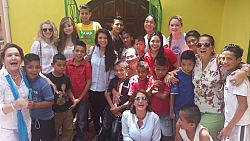St. Joseph students' visit to Nicaragua was 'unforgettable'
Friday, Aug. 01, 2014

Alicia Behnken
+ Enlarge
Saint Joseph Catholic High School students spend time at Los Quinchos. Courtesy photo/Alicia Behnken
OGDEN — Alicia Behnken accompanied two of her Saint Joseph Catholic High School Spanish students to her home country of Nicaragua in July so they could experience its culture, language and also witness how they could be of service to many people, especially young children.
Rachel Sutherland and Bailey Pacheco graduated this year from SJCHS, and wanted to learn about Nicaragua firsthand.
“I’ve been in the United States for 31 years, and every year I go to Nicaragua to see my parents in Ocotal and focus on social justice projects,” said Behnken. “My mother knows a lot of the rural areas in need. I like to expose the students to the history of Nicaragua and to opportunities to help the poor.”
As they traveled, they saw poverty, but they also saw how other people help. At Los Quinchos, a non-profit organization in San Marcos, they met children aged 4 to 18 who had been saved from roaming the streets of Nicaragua, where they had been involved in sex, drugs, and alcohol and were in trouble with the law.
One who was rescued, Alberto, said if people hadn’t helped him he probably wouldn’t have had a chance in life, said Behnken. “Alberto had been in trouble by age 11 and is now 24 and helping other kids succeed at Los Quinchos; he is going to graduate from the university,” she said.
Sutherland said the trip was unforgettable. “While I was there, I was able to meet and converse with people of diverse social and economic backgrounds and immerse myself into the culture,” she said. “The very recent tumultuous past was obvious; political tensions still exist. It’s different when you see the actual poverty; it was sort of a surprising shock, but I was grateful to speak with them and learn about them.”
The experience that had the most impact on Sutherland was learning about the history of Granada, she said. “Throughout its history, this beautiful colonial city exemplified foreign powers’ ability to affect Nicaragua’s past, present and future, which influenced its architecture as well as its social and economic climate,” she said. “It is a city that will remain in my heart and on my mind forever. It reaffirmed my goal to study Latin American Studies in college.”
Pacheco, who had never before been outside the United States, fell in love with the culture and the people, she said.
An experience that was prominent for Pacheco was at Los Quinchos, she said. “I’ve been in community centers before, but these kids ... meeting them, especially one, Pablo, who was 12, was an experience I will never forget. Pablo was so innocent, sweet and open. From the moment I met him, he was friendly and grabbed my hand and was attached to me. He gave me the bracelet that he had made and was wearing. Los Quinchos has a soccer field and a pool, but it is not modernized, there are no computers. What mattered to me the most was knowing that these kids are happy; it was sad to leave.”
Seeing how the Nicaraguan people live without cars, some without beds, in houses made of tin and cardboard, was “eye opening for me,” said Pacheco. “I would even say some are happy as long as they have their family, because without family they feel they have nothing in Nicaragua. It is my goal to go back.”
Behnken plans to collect clothing and soccer equipment during the next year and return to Nicaragua in 2015 to distribute the donated items, she said.
For questions, comments or to report inaccuracies on the website, please CLICK HERE.
© Copyright 2025 The Diocese of Salt Lake City. All rights reserved.
© Copyright 2025 The Diocese of Salt Lake City. All rights reserved.

Stay Connected With Us